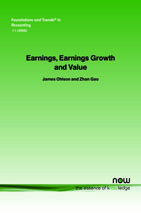Earnings, Earnings Growth and Value
By James Ohlson, William P. Carey School of Business, Arizona State University, USA | Zhan Gao, William P. Carey School of Business, Arizona State University, USA
Abstract
A recent paper by Ohlson and Juettner-Nauroth (2005) develops a model in which a firm's expected earnings and their growth determine its value. At least on its surface, the model appeals because it embeds the core principle used in investment practice and, further, generalizes the Constant Growth model (Gordon and Williams) without restricting the firm's dividend policy. This text reviews the valuation model and its properties. It also extends previous results by analyzing a number of issues not adequately covered in the original paper. These topics include the precise nature of dividend policy irrelevancy, how the model relates to other well-known valuation models, the role of accounting principles, and how it can be developed on the basis of an underlying information dynamics. A central result shows why the model should be accorded "benchmark" status.
Earnings, Earnings Growth and Value
Earnings, Earnings Growth and Value presents a model of earnings and dividends leading up to the core principle that growth in earnings explains the price to forward-earnings ratio. This model is referred to as the OJ (Ohlson and Jeuttner-Nauroth) model. The OJ model takes into account two growth measures of earnings – the near term and the long term 舑 to explain the price to forward-earnings ratio. Further, the model allows for a broad set of dividend policies.
Earnings, Earnings Growth and Value starts from the basics and derives the valuation formula which shows how value depends on earnings and their growth. Some of the topics developed here are include dividend policy irrelevancy (DPI), how one extends the model to incorporate an underlying information dynamic, accounting rules and their influence on the model, and ways in which the model can be extended to reflect operating vs. financial activities.
Earnings, Earnings Growth and Value should be required reading for researchers in accounting and finance with an interest in accounting theory, equity valuation and financial accounting.
